Top News
January 7, 2016 Ryukyu Shimpo
By Takahiro Miyagi
Recently, residents living around Kadena Air Base raised the concern of a bad stench to the prefectural government. On January 6 in response to this concern, the prefectural government decided to pursue a plan to designate the town of Kadena as an odor regulation area based on Offensive Odor Control Law. The prefectural government will inquire about designation to a prefectural advisory panel on the environment that opens toward the end of this month. If the government receives a response by the end of the fiscal year in March, Kadena could be designated as an odor regulation area in April. In that case, when a foul odor occurs, a government-authorized odor analyst will come to the town of Kadena to measure the odor level.
The stench wafting from Kadena Base is speculated to be that of exhaust and gas from U.S. military aircraft, but these suspicions are not yet confirmed.
Since domestic Japanese laws do not apply within US base compounds, the U.S. military is not subject to recommendations or orders from the Japanese government to improve the situation. At the same time, Okinawans hope to use measured results from odor analysis as indicators when appealing to the relevant authorities for improvements.
Offensive Odor Control Law generally applies to odors expelled from factories or plants rather than military facilities. Regulation of odors is based on an odor index, and the odor index of a stench in an area is measured by human sense of smell. This method of measurement ensures detection of odors that may not be numerically measureable by a machine. A revision of the 1996 Offensive Odor Control Law was implemented in Okinawa in 2006, stipulating the human nose as the tool of determining odor level. Now, 15 municipalities are designated for odor regulation under Offensive Odor Control Law, including Okinawa City, Ginowan City, and Naha City.
Once the advisory panel on the environment gives its advice and a municipality is designated as an odor regulation area, the municipal government is in charge of measuring odor levels and ensuring that the instigator of any stench, whether it is a factory or construction site, improves the situation.
(English translation by T&CT and Erin Jones)
Go to Japanese
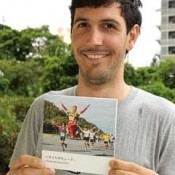
January 7, 2015 Ryukyu Shimpo
By Yoshiki Nagahama
New Zealander Jesse Whitehead, 25, recently published a photography book depicting the people, nature, and culture of Okinawa as he experienced them during his three-year stay in Tomigusuku City, which ended in December. Captions for the photographs in his book include lines from the Okinawan song Tinsagu nu Hana, and Okinawan “kugani” (proverbs).
Whitehead says he was moved by the beauty of the lyrics and sayings, which endeavor to convey Okinawa’s traditional wisdom and culture across generations. Whitehead believes that the lines send an important message that is common to cultures all over the world. Attached to a photograph of a child’s brilliant smile is the lyric, “Uya nu yushigutu ya chimu ni sumiri (let the words of your parents color your heart),” from Tinsagu nu Hana. A photograph of Okinawa soba is captioned with the proverb, “Kamuru ussa mi nayun (the more you eat, the healthier you will be).”
Whitehead came to Okinawa in August 2012 as an Assistant Language Teacher at a high school. During his stay, he traveled far and wide around all the islands of Okinawa. He participated in local events and met many people during his travels.
The photographs in Whitehead’s book were taken between March 2014 and April 2015. He says that after living in Okinawa for three years, he has come to think of it as his second home. In addition to Okinawa’s beautiful oceans and diverse culture, Whitehead says one thing that made an impression on him was that everywhere he went, people greeted him with warmth and kindness. The memories of each and every person he met in Okinawa, he says, are the reason he titled his book “Ichariba Chode,” which means, “once we meet, we are like brothers and sisters.” He says he wants to say thank you to every single person he met in Okinawa.
Whitehead says that more than anything, he wants to tell Okinawan high school students that if they have the chance, they should travel abroad and try many new and different things.
In addition to bringing his book home to New Zealand to teach people about Okinawa, Whitehead also plans to exhibit his photography. His book is ¥500, not including shipping. For more information, please contact j.sensei101@gmail.com.
(English Translation by T&CT and Sandi Aritza)
Go to Japanese
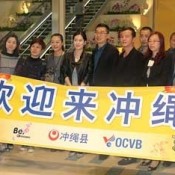
January 7, 2016 Ryukyu Shimpo
Seventeen visitors from Amoy, Fujian in China arrived at Naha Airport on January 6 to participate in “medical tourism” in which participants get health check-ups while enjoying resort tourism in Okinawa. The participants stayed for five nights while getting medical examinations at Tomishiro Central Hospital and Toyosaki Clinic. The participants also visited Gyokusendo, Okinawa Churaumi Aquarium, Kouri Island and other tourist spots.
The executive director of the Naha Tourism Association, Masato Nakamura, greeted the visitors at a reception held at the Naha International Airport terminal building. Nakamura said to them, “Please enjoy your stay in Okinawa while getting health check-ups at the wonderful medical facilities.” A 62-year-old hospital director from Amoy, Huang Jin Fang, commented, “Okinawa has high quality medical services, and I would also like to enjoy the nature. I hope to build a friendship with the people of Okinawa.”
Chairperson of the Thai Eastern International Medical Tourism Service, Shao Yujia, who planned the tour, talked about the significance of the tour. Uka said, “They can experience quality medical services within the wonderful nature of Okinawa.”
(English translation by T&CT and Sayaka Sakuma)
Go to Japanese
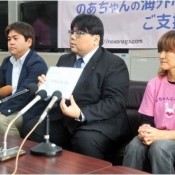
January 6, 2016 Ryukyu Shimpo
On January 5, Operation Save Noa, a volunteer group to support one-year-old Noa Onaga who needs to travel to the United States for a heart transplant because of a severe heart disorder, held a press conference at the Okinawa Prefectural Government building. The organization announced that their fundraising had hit a target of 320 million yen within three months of starting last September. Noa and her parents will go to the United States in the week of the 17th of this month.
Noa will be examined at Columbia University Medical Center in New York and wait for a donor to be found. The support group assumes that it takes one to three months from arrival in the United States to get a heart transplant, according to previous cases. Noa’s family is planning to stay in the United States for one year, including the hospitalization time after the surgery.
A representative of the support group, Makoto Taira, said, “We strongly feel the weight of the support from people in Okinawa and throughout Japan. We will continue to support Noa until she comes back well to Okinawa.” The group will consider donating to other organizations if there is any surplus from the fund. A representative of the group stated, “We will give out the money in adherence with the spirit of mutual help.”
Noa’s father, Tsukasa, 39, showed his appreciation and said, “We want to show everyone a healthy Noa without a partial mechanical heart.”
(English translation by T&CT and Megumi Chibana)
Go to Japanese

January 5, 2016 Ryukyu Shimpo
Okinawa’s child poverty rate hit 37.5 percent in 2012, the highest in Japan. On January 4, Kensaku Tomuro, Associate Professor of Yamagata University, announced the findings of his nationwide child poverty rate survey. Results revealed that over one-third of Okinawa households with children under 18 years old are living in poverty. Okinawa’s poverty rate is about 2.7 percent times the national average of 13.8 percent. Although Osaka’s poverty rate (21.8 percent) is the second highest, Okinawa is more than ten points higher than Osaka. In addition, Tomuro calculated Japan’s overall poverty rate, including households with no children. According to his findings, Okinawa’s overall poverty rate is 34.8 percent, which is 16.5 points higher than the national average. In other words, more than one out of three households in Okinawa is living in poverty.
Based on the Comprehensive Survey of Living Conditions conducted by the Ministry of Health, Labor, and Welfare in 2012, the latest nationwide poverty rate is 16.3 percent.
Tomuro states, “The Okinawa region has held the highest poverty rate for these past two decades,” in his article scheduled for publication this February. In order to alleviate the situation, Tomuro proposes, “Welfare benefits should be completely state-funded. This will help to improve the welfare-recipient rate nationwide.” Having said that, he calls for state measures to drastically raise the minimum wage and to regulate non-regular forms of employment.
At 25.9 percent, Okinawa has the highest working-poor rate in Japan, which is 9.7 percent higher than the national average. When the survey was previously conducted in 2007, Okinawa’s poverty rate was 20.5 percent. The situation has been steadily worsening with a 5.4 percent increase since then.
In addition, the “welfare-recipient rate,” which indexes the proportion of households living on welfare benefits, is a mere 1.5 percent in Okinawa. This reflects the reality that many economically deprived families live without any support at all.
For every five years from 1992 to 2012, Tomuro has calculated the poverty rate, “welfare-recipient rate,” and “working-poor rate” by prefecture. Tomuro bases these figures on the “Basic Survey on Employment Structure”, “Survey on Public Assistance Recipients“ and “National Survey on Public Assistance Recipients” conducted by the government. “Child poverty rate” refers to the proportion of households with an income below the minimum cost of living, of those raising a child under 18 years old.
Tomuro’s article will appear in the forthcoming issue of the “Faculty of Literature and Social Sciences, Yamagata University Annual Research Report, Vol. 13” this February.
(English Translation by T&CT, Kaya Doi)
Go to Japanese
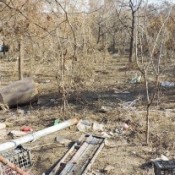
January 4, 2016 Ryukyu Shimpo Tsuyoshi Arakaki reports
There are burial sites in Beijing for Ryukyuans (Okinawans) who sought for the Chinese Qing Dynasty to save the Ryukyu Kingdom and who died in exile before and after the “Ryukyu disposal”, when the Ryukyu Kingdom was annexed by the Meiji government in 1879. The burial sites, which are located in apple fields, are under threat of development, without investigation, and the remains and their relics are still left there.
Zhangjiawan Town, Tongzhou District, Beijing, where the burial sites are located, is included in the government development plan. Some of the capital functions will be moved to the area and a large theme park will be constructed. The construction will start this year. Chinese researchers on the history of relations between China and Ryukyu are striving to carry out excavation surveys and collect the remains, but time is limited.
Several burial sites for the Ryukyuan people, including envoys, students from the kingdom and royalists who sought to save their country from Japanese invasion, are found at Zhangjiawan. The gravestone of Wang Dayie, a royalist from Kume Village belonging to the scholar-officials class of the kingdom, stands there. About 14 Ryukyuan people are buried in the apple fields of Li Chan An Cun, Zhangjiawan. The apple fields are surrounded by traditional courtyard residences, which retain the feel of the old days. However, it is still easy to excavate the remains because of the fields.
Chinese scholars, including Bu Ping, the director of the Institute of Modern History, the Chinese Academy of Social Sciences, and Jiang Hong, a professor at Beijing Normal University, are striving to carry out an investigation to preserve the burial sites. Jiang said, “We will continue to work positively in order to excavate the Ryukyuan burial sites, restore and preserve them as proof of the history of friendship and exchange between China and Ryukyu for about 500 years.”
Tongzhou District Office has a plan to build a museum. An official of the district said, “We want to carry out an investigation before the start of the development, and we will collect the remains and their relics to preserve them in the museum.” However, future challenges remain, such as creating a concrete plan and how to get a budget for the project.
Seventeen Okinawan researchers, including Masaki Tomochi, a professor at Okinawa International University, sent a petition to Chinese scholars on December 14. Tomochi said, “The excavation and research for Beijing’s Ryukyuan burial sites and the restoration to preserve them are very important as proof of the long history of friendship and exchange between Ryukyu and China, and as a foundation for future friendship.”
Morikiyo Matayoshi, an affiliate professor at Okinawa University, has carried out research on the Ryukyuan burial sites in Beijing for many years. Matayoshi said, “These burial sites are the place to prove that Ryukyu staged a campaign for national salvation as an independent country, and also proof that the Ryukyu Kingdom had friendships and exchanges with countries of East Asia. We can’t allow valuable sites to be destroyed. We should seek for Chinese officials to carry out an early investigation through the Okinawa Prefectural Government.”
(English translation by T&CT)
Go to Japanese
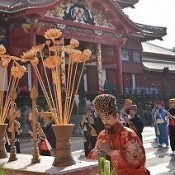
January 1, 2015 Ryukyu Shimpo
From January 1 to 3, a New Year’s ceremony was held at Shurijo Castle Park, Naha. The Chouhaiokishiki, or Imperial Court New Year’s morning ceremony, which used to take place at Shuri Castle on New Year’s Day during the Ryukyu Dynasty, was demonstrated. Many people watched the ceremony and the king and others wearing extravagant clothing.
Naoki Tada and his family visited Okinawa for the first time. He said, “Our image of Shuri Castle was only Shurei no mon or Shurei gate. But the ceremony was solemn and we felt the depth of the history.”
On January 3, the king and queen appeared in the forecourt and Ryukyu traditional dance and music was performed, and tea and amazake were served.
(English translation by T&CT, Hitomi Shinzato)
Go to Japanese

December 24, 2015 Ryukyu Shimpo
New York-based artist Yuken Teruya is known for Okinawan traditional bingata dye works, including one featuring parachuters, fighter aircraft, Osprey and dugong in a beautiful design. In an interview with freelance journalist Chota Takamine, the Okinawan artist talked about his position on U.S. military bases in Okinawa.
Q: What is your position on the construction of a new U.S. military base in Henoko?
A: I simply oppose it. I have lived in the United States for over 17 years, and have been invited to hold art exhibitions featuring the base issues of Okinawa. However, my main theme is how I can make American people feel connected with those issues. I think art is a suitable format to express this theme. By making art museums in Europe and the United States display pieces featuring the base issues of Okinawa, I want to make the Okinawan protest movement against the bases cultural heritage.
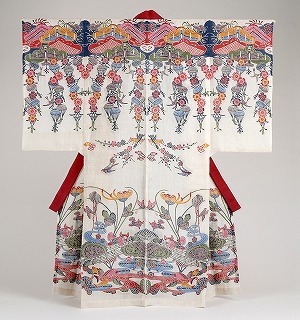
“Yu-I” bingata dye work featuring parachuters, fighter aircraft, Osprey, and dugong in a beautiful design (by Yuken Teruya).
Q: Do you have any suggestions on how to solve the base issues as an Okinawan who is based in New York?
A: American citizens are also struggling with various problems and debating over them. As represented by the Occupy Wall Street movement that occurred in 2011, each and every person in the United States continues to work on solving their problems. I think one idea is to let U.S. military personnel know why the people of Okinawa are against the bases from a common ground. For example, Okinawan people should hold picket signs saying, “Tax,” “You owe us electricity,” and let the military personnel know the Japanese citizens pay tax to maintain the U.S. bases in Japan. From common subjects such as tax, I want to exchange opinions with U.S. military personnel about burdens on both Okinawan people and them.
Q: You took part in sit-in protests against the new base construction in Henoko and helipads in Takae July 2015.
A: Although I have various ideas about how to protest, I feel frustrated at times because I cannot carry them out once I get there. I do not know whether or not my vision of the protest movement is clear or my commitment to the movement is enough. I cannot have enough communication with the people protesting. When I returned to Okinawa and took part in the protest, I sometimes ended up going back to the United States with dissatisfaction. My theme is to build relationships of trust and understanding with those protesting and carry out my own ideas of the protest while keeping some distance. I think it is effective to shed light on the base issues through art projects. Artworks can easily be accepted by the people in the U.S. bases.

“Parade From Far Far Away” bingata dye work telling the story of Okinawans parading in the future while looking back on history after the issues of the U.S. military bases in Okinawa have been solved (by Yuken Teruya).
When I took part in sit-in protests in Takae and Henoko, the people working for bases took photographs of me from inside of their cars and the fence. I was worried about whether or not I could safely return to the United States. My mother who used to be involved in a nature conservation movement, told me that you are not going to have any problems if you can explain your situation by arming yourself with a knowledge of laws. In order to do that, you need to learn your own rights by taking cognizance of the law. Some American scholar once said that you could say constitutions exist only if you can recognize and precisely talk about them. You cannot protect your own rights if you don’t study. In order to do that, I think debate is useful. You can deepen knowledge of laws and politics while having fun and interests through debate. I think Okinawa is the best place to do that.
I think the style of protests in Europe is sophisticated. It is not difficult to effectively use various styles for protesting. I think it is nice for Okinawan people overseas and those in Okinawa to work together.
Q: Do you have any advice for young Okinawans who want to become big overseas?
A: If you believe in your talent, it is enough. If you can do something that people in your region appreciate, you can do the same in the United States. Even though you are not acknowledged by your schools, you are the real deal if you can prove them wrong. Even if your talent continues to be ignored and you continue to miss the timing, I want you not to ignore what you want to do and your belief in what you can do. While some people appreciated me, others didn’t. I owe my entire career to a strong belief in my capability. Life in the United States is not easy. If you do not believe in yourself, you could ruin what you have done up to now.
You can find a unique way to work effectively in the field of art. It needs a different effort from company employees. It is important to manage your schedule as an artist and create artworks that can move people.
Biography:
Yuken Teruya was born in Haebaru Town, Okinawa in 1973. Teruya graduated from Tama Art University. After completing his master’s course at the School of Visual Arts in New York, he has been based in New York.
Chota Takamine was born in Naha City, Okinawa in 1978. Takamine graduated from the University of San Francisco, majoring in Media Studies. He works as a translator and journalist.
(English translation by T&CT)
Go to Japanese
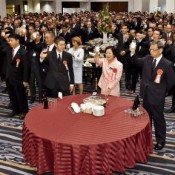
January 5, 2016 Ryukyu Shimpo
Thirty-one economic organizations including Okinawa Prefectural Federation of Chamber of Commerce and Industry met for a New Year’s banquet on the evening of January 4 at the hotel ANA Crowne Plaza Okinawa Harborview in Naha. In order to strengthen the trend of expansion in Okinawa’s economy, various industries represented at the banquet resolved to come together to realize a new stage in Okinawa’s economic development, with an eye on growing Asian markets.
About 650 people attended the banquet. Yukikazu Kokuba, head of both the Okinawa Prefectural Federation of Chamber of Commerce and Industry and of the Council of Okinawa Prefectural Economic Organizations, delivered a greeting at the banquet as a representative hosting the event. In his greeting he mentioned that tourism, as the leading industry of Okinawa, will continue to grow. Investments from both Okinawa and other parts of Japan for construction of hotels and the like, he said, provide an important boost to strengthening the tourism industry. In addition he stated that making Okinawa a forerunner requires flexible responsiveness.
Governor Takeshi Onaga delivered an address as a guest speaker, expressing his sense that Okinawa has the potential to act as a hub within Asia for telecommunications and for international logistics. If the outlying islands are developed and made inviting to tourists, he said, tourism to Okinawa will increase. He hopes that Okinawa’s economy will further develop and gain distinction in the economic world.
(English translation by T&CT and Erin Jones)
Go to Japanese
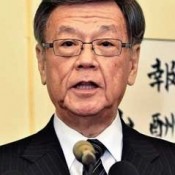
January 5, 2016 Ryukyu Shimpo
On January 4, Governor Takeshi Onaga made his new years’ greeting to prefectural employees over the Prefectural Office’s broadcast system. In the greeting, he expressed his determination to continue working to prevent the construction of a new U.S. military base in Henoko, Nago as part of the planned relocation of U.S. Marine Corps Air Station Futenma. “The U.S. military base issue is a critical issue for Okinawa,” said Onaga. “I believe that if our generation provides an example by taking on the responsibility [of dealing with this issue] and refuses to give in, it will instill in the next generation a sense of confidence, courage and pride.”
Regarding the issue of childhood poverty, Governor Onaga stated, “Even as Okinawa’s economy continues to grow stronger, the fruits of that growth are not reaching every sector of society. I especially intend to work hard on tackling childhood poverty.”
2016 marks the fifth year of the “Okinawa 21st Century Vision Basic Plan,” a ten-year development plan for Okinawa. Regarding this, Governor Onaga stated, “We will powerfully promote Okinawa’s development in the next five years based on a review of our successes to date and an assessment of the challenges that remain.” Regarding economic development in particular, Governor Onaga remarked on the “Okinawa Asia Economic Strategy Initiative” announced last September, saying, “In order to achieve the goals [put forth in the Initiative], I hope to see concrete plans formulated and measures enacted to hasten the development of an independent Okinawan economy.”
(English Translation by T&CT and Sandi Aritza)
Go to Japanese
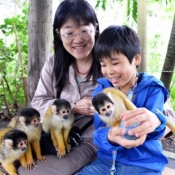
January 1, 2016 Ryukyu Shimpo
Pretty squirrel monkeys cheerfully played and jumped up on peoples’ shoulders on Ishigaki Island for the beginning of the year of the monkey. The 59 monkeys met the visitors at the Risuzaru no mori (squirrel monkeys’ forest), Yaima Village in Nakura, Ishigaki City.
The monkey’s forest had 12 baby monkeys newly born last year, which is the biggest number in the past 10 years. The park is expected to be more popular with the lucky news.
The small monkeys are called squirrel monkeys as they move quickly like squirrels. The species originally inhabited rain forests in southern America. They grow to about 30cm tall, excluding their tail, and bigger individuals can weigh about 1kg. Tails are longer than bodies, with lengths up to 40cm.
A 10-year-old tourist from Saitama Prefecture, Shunsuke Uchida, happily enjoyed the adorable monkeys. His 49-year-old mother, Fumiko, smiled as she commented, “I would like our family to be close and the year full of hope. I also would like our child to find new goals.”
Megumi Tokuyama, who is in charge of breeding the monkeys, said, “I hope many families can spend a happy time playing with the monkeys.”
(English translation by T&CT and Sayaka Sakuma)
Go to Japanese












 Webcam(Kokusai Street)
Webcam(Kokusai Street)


